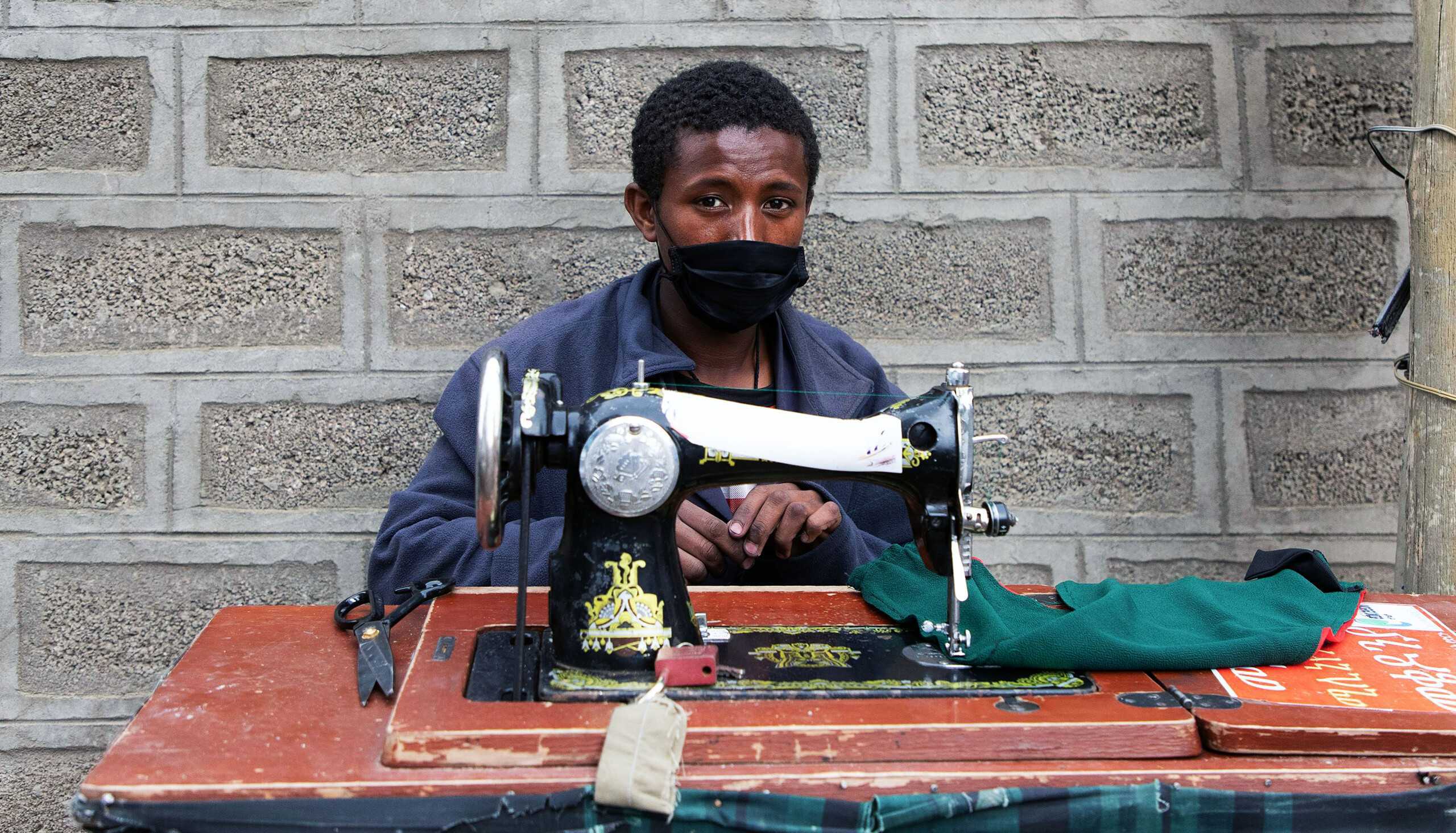Action against poverty: Covid-19 impacts in 2021

Young boy in Addis Ababa, Ethiopia, sewing clothes outdoor on the street during Covid-19 outbreak. Photo by Alazar Kassa. (Shutterstock, 2020).
Action against poverty: Covid-19 impacts in 2021
Within today’s reality, the COVID-19 pandemic and the economic shutdown all over the world have disrupted billions of lives and are jeopardizing decades of development progress.
The pandemic caused a global recession. Although global economic activity is growing again, it is not likely to return to business as usual for the foreseeable future. The pandemic has summoned a severe loss of life, is tipping millions into extreme poverty, and is expected to inflict lasting scars that push activity and income well below their pre-pandemic trend for a prolonged period (World Bank Group, 2021, p. 25).
Finally, the COVID-19 poverty implications include severe effects on the poor, such as: greater vulnerability to declines in labor and non-labor income, increased risk of infection and mortality, and lower availability of essential items due to market disruptions. Although the social assistance measures that have been implemented by many countries may soften the impacts on households, they do not fully offset the income losses from lockdowns (World Bank Group, 2020, p. 165).
How does poverty look today?
The number of people living in extreme poverty worldwide has fallen by more than 1 billion people since the 1999. However, part of the success is set to be reversed due to the pandemic. As the new year brings some hope for the fight against COVID-19, The World Bank is looking back and taking stock of the effect of the pandemic on poverty in 2020. In October 2020, the World Bank estimated that 88-115 million people around the globe would be pushed into extreme poverty in 2020. It is now expected that the COVID-19-induced new poor in 2021 to rise to 119-124 million. While the estimates for 2021 are very preliminary, it goes to show that for millions of people this crisis will not be short-lived (Lakner et al., 2021).
Does this mean that progress on the reduction of poverty and inequality will likely be lost? It is believed that the United Nations’ (UN) 2030 Agenda for Sustainable Development is still a promising method to end the differentiation between developing and developed countries, with its first goal to end worldwide poverty. The purpose is to transform the world by following 17 Sustainable Development Goals (SDGs) with one core principle of the agenda, which is: “Leave No One Behind” (Global Call to Action Against Poverty, 2021). The UN responded to COVID-19 with the issuing of the Framework for the Immediate Socio-economic Response to COVID-19, calling for a scale-up of international support and political commitment to ensure that people, everywhere, have access to essential services and social protection. Additionally, the UN established the COVID-19 Response and Recovery Fund to, specifically, support low- and middle-income countries with vulnerable groups who are disproportionately bearing the socio-economic impacts of the pandemic.
Is it possible to achieve the SDGs by 2030?
Indeed, the poorest and most vulnerable countries and populations have been hit hard by the pandemic, putting several of the SDGs even further out of reach. A further erosion in global cooperation risks reducing the world’s ability to deal with increasingly urgent trans-national problems, including future health crises as well as climate change and global poverty (World Bank Group, 2021, p. 24).
Looking at the three scenarios for the SDGs discussed in the Sustainable development outlook 2020 issued by the UN Department of Economics and Social Affairs (UNDESA), the situation becomes clearer and brings different perspectives on Agenda 2030. The first scenario is the “pre-COVID-19 scenario,” based on the trends that held during the pre-COVID-19 years. The second and third scenarios are post-COVID-19, named for short as “COVID-19 pessimistic” and “COVID-19 optimistic.” Which of these two scenarios takes hold of a country depends on whether it can: minimize the damage caused by COVID-19; recover quickly from the damages; hold on and build further on the positive changes introduced to its healthcare, social protection, and governance systems during the COVID-19 crisis; sustain and bolster the positive gains that were made regarding planet-related SDGs during the COVID-19 crisis; and re-energize the effort toward sustainable development. Should countries succeed at the above, they will enter the optimistic scenario. Otherwise, the pessimistic scenario will prevail, driving the country further away from attaining the SDGs (UNDESA, 2020).
The circumstances of year 2020 created a gap in the progress towards the goals of Agenda 2030 and exposed societal shortcomings. As humanity enters 2021, everyone needs to continue to work together to face the consequences of the pandemic, and put the SDGs at front and centre of a just, green recovery that leaves no one behind (The Global Goals, 2021).

Article by
Arina Gurevich

Categories


